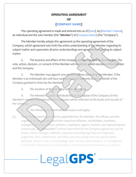What to Do When You Forgot to Use a Contract
It started out casual—maybe it was a quick job for a client you trusted, a verbal agreement with a friend, or a rush to get a project moving. But now...
9 min read
LegalGPS : Jun. 19, 2025
In today's dynamic business landscape, companies of all sizes are increasingly turning to freelancers to fulfill specific project needs, access specialized skills, and maintain flexibility in their workforce. The gig economy has experienced explosive growth, with approximately 36% of U.S. workers participating in freelance work as of 2023. For businesses, tapping into this vast talent pool offers numerous advantages – from cost savings to access to global expertise.


Legal GPS Pro
Protect your business with our complete legal subscription service, designed by top startup attorneys.
However, navigating the process of hiring and managing freelancers comes with unique challenges. From finding the right talent to establishing proper legal protections, businesses must approach freelancer relationships strategically to maximize benefits while minimizing risks. This comprehensive guide walks you through the essential steps to successfully hire and work with freelancers.
Before posting a job listing or reaching out to potential freelancers, take time to clearly define what you're looking for. This critical first step sets the foundation for a successful freelancer relationship.
Start by documenting exactly what you need accomplished. Consider:
The more precise you are about your requirements, the easier it will be to find the right match and avoid misunderstandings down the line.
Consider whether a freelancer is truly the best solution for your needs. Freelancers are ideal for:
However, if you need ongoing work with close supervision and control over when and how tasks are completed, an employee might be more appropriate.

Consulting Agreement
Download our Consulting Agreement Template to formalize your consulting services. Protect your business with a clear comprehensive contract.
Trusted by 1,000+ businesses to safeguard their LLCs.
Research typical rates for the type of work you need. Freelancer rates vary dramatically based on:
Remember that the lowest bid isn't always the best value. Experienced freelancers who charge premium rates often deliver higher quality work more efficiently, potentially saving you money in the long run.
A detailed project brief is your most powerful tool for attracting qualified freelancers and ensuring project success. Your brief should include:
Consider creating a brief template that you can adapt for different projects to maintain consistency in your freelancer hiring process.
With your needs clearly defined, you're ready to begin your search for the perfect freelancer.
Several specialized platforms connect businesses with freelance talent:
Industry-specific platforms often provide more carefully vetted candidates but may come with higher fees or rates.
Beyond these platforms, consider:
Once you've identified potential candidates, thoroughly assess their previous work:
Don't hesitate to ask candidates for additional samples or references if needed.
Be alert to warning signs that might indicate a problematic working relationship:
Company: DesignHub, a mid-sized marketing agency
Need: Web designer for client projects
Vetting Process:
Result: Found an exceptional designer who became a long-term collaborator for multiple projects, saving the time and expense of repeating the hiring process.
The legal aspects of hiring freelancers are among the most critical and often overlooked elements of the process.
Misclassifying workers can lead to significant penalties and legal issues. Generally, freelancers should:
If you're dictating when, where, and how work is performed, providing equipment, or requiring exclusivity, you might be creating an employer-employee relationship.
As the hiring party, you need to:
Consider consulting with a tax professional to ensure compliance with current regulations.
Without proper agreements, intellectual property rights can become complicated. Ensure your contract clearly specifies:
Never work without a written agreement. Even for small projects, ensure your freelancer contract includes these critical elements:
Have your contract template reviewed by a legal professional specializing in employment or contract law to ensure it provides adequate protection.
Building on the legal considerations, let's explore how to create contracts that protect both parties and set the stage for successful collaboration.
A solid freelance contract should include:
Common payment approaches include:
For new relationships, consider a hybrid approach that might include a smaller upfront payment, milestone payments, and final payment upon completion.


Legal GPS Pro
Protect your business with our complete legal subscription service, designed by top startup attorneys.
Break larger projects into clear phases with specific deliverables. This approach:
Define acceptance criteria for each milestone so both parties understand when work is considered complete.
Client: TechStart Solutions
Project: Website redesign
Contract Framework:
Once you've hired a freelancer, effective management is key to project success.
Clear communication is essential when working with remote freelancers:
Beyond the contract, discuss working preferences:
Effective feedback helps freelancers deliver better results:
The right tools can significantly improve your freelancer relationships:
Create a simple onboarding document with links and login information for all relevant tools to help freelancers get up to speed quickly.
Establishing reliable, efficient payment processes is crucial for maintaining positive freelancer relationships.
Common payment options include:
Consider offering multiple payment options to accommodate freelancer preferences.
When working with global talent, be aware of:
Build these considerations into your timeline and budget when hiring internationally.
Maintain proper tax records by:
Project: Marketing content creation
Three Different Payment Approaches:
As your business grows, you may find yourself working with multiple freelancers across different projects.
Develop relationships with a trusted pool of freelancers by:
Consider transitioning freelancers to employees when:
Have open conversations about these possibilities with your top freelancers.
Coordinate larger freelance teams by:
Maintain a centralized system to track freelancer information:
This database becomes an invaluable resource when new projects arise, allowing you to quickly identify and reach out to the right talent.
Hiring freelancers can transform how your business operates, providing access to specialized talent, increasing flexibility, and potentially reducing costs. The key to success lies in approaching these relationships strategically – from clearly defining your needs and establishing legal protections to building lasting professional relationships.
Remember that the freelance marketplace is relationship-driven. By treating freelancers as valued partners rather than interchangeable vendors, you'll build a reliable network of professionals eager to contribute to your business success.
As you begin or expand your work with freelancers, start with these key actions:
With these foundations in place, you'll be well-positioned to leverage the tremendous talent available in today's global freelance marketplace.
The biggest question now is, "Do you need a lawyer for your business?” For most businesses and in most cases, you don't need a lawyer to start your business. Instead, many business owners rely on Legal GPS Pro to help with legal issues.
Legal GPS Pro is your All-In-One Legal Toolkit for Businesses. Developed by top startup attorneys, Pro gives you access to 100+ expertly crafted templates including operating agreements, NDAs, and service agreements, and an interactive platform. All designed to protect your company and set it up for lasting success.

Legal GPS Pro
Protect your business with our complete legal subscription service, designed by top startup attorneys.
|
Premium Template
Single-use Template |
Legal GPS Pro
Unlimited Access, Best Value |
|
|
| Choose Template | Learn More |
| Trusted by 1000+ businesses | |

It started out casual—maybe it was a quick job for a client you trusted, a verbal agreement with a friend, or a rush to get a project moving. But now...

You’re a freelancer, thrilled to land a big client, but their contract arrives, and it’s a red-flag parade: they can cancel anytime, you’re liable...

You’re a freelancer selling your graphic design business, and a $10,000 client contract is part of the deal. You want to transfer it to the buyer,...